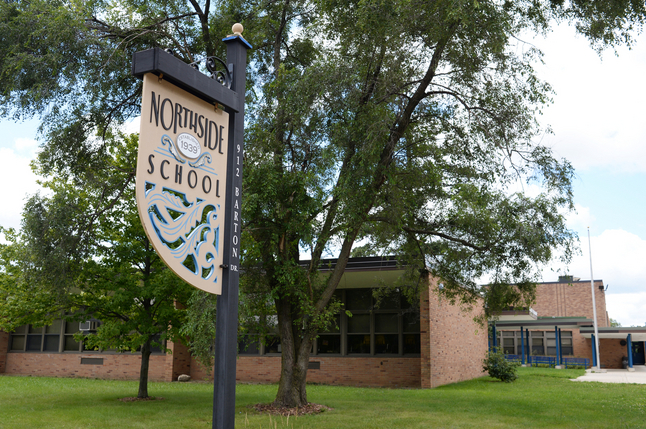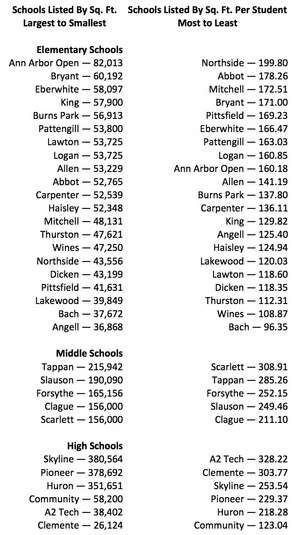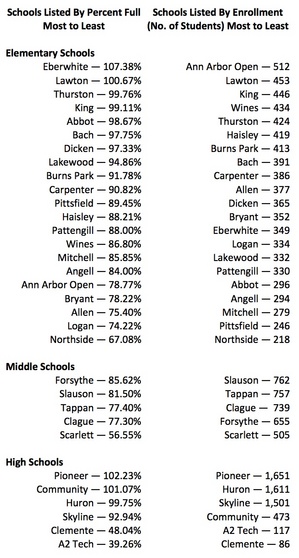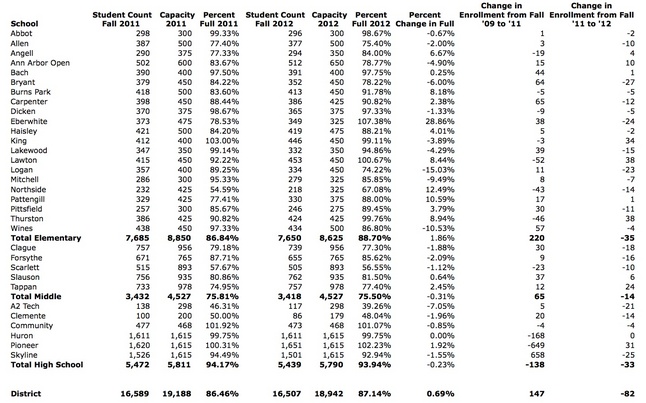By the numbers: Officials say redistricting is chance to 'right size,' save money and increase programs

New data shows that the under-enrolled Northside Elementary School in Ann Arbor has the most square feet per student.
Melanie Maxwell | AnnArbor.com
As the Ann Arbor Public Schools assesses an appropriate timeline for considering building closures and redistricting, the focus has shifted from not just how to save money and tighten operations, but also how to expand program offerings for students.
Yet with Ann Arbor's elementary schools operating at 88.7 percent full and its high schools operating at 93.94 percent full, the question becomes which schools can close and where can successful programs expand?
AnnArbor.com computed the number of square feet per student at each building in AAPS using fall 2012 enrollment data and total building square footage figures supplied by the district in order to explore options within AAPS buildings.

School rankings by total square footage (left) and by square feet per student (right).
Computed by AnnArbor.com
According to the data, Northside Elementary, which is the sixth smallest elementary school, has the most square feet per student (199.8 feet), out of all 21 elementaries. Bach Elementary, which is operating at 97.75 percent full, has the least amount of square feet per student (96.35).
Northside also has the smallest student enrollment (218) and is operating the least percent full, at 67.08 percent of its capacity.
In grades 6-8, Scarlett Middle School students have the most square feet per student (308.35). And in grades 9-12 at the comprehensive high schools, Skyline students have the most amount of room, 253.54 feet per student. However, Huron and Pioneer are not far off the mark at 218.28 square feet per student and 229.37 square feet per student, respectively.
For the alternative high schools, Community High School has 123.04 square feet per student. Roberto Clemente and Ann Arbor Technological high schools have more than 300 square feet per student; they also are under-enrolled at 48.04 percent full and 39.26 percent full, respectively.

School rankings by percent full (left) and by 2012 fall student enrollment (right).
Computed by AnnArbor.com
AAPS was forced to hit the pause button on its redistricting efforts after two requests for proposals for a consulting company to help the district with its process did not yield what officials had hoped.
Now AAPS is waiting for word about a possible partnership with a research group from the University of Michigan — and for the district's new superintendent, Jeanice Kerr Swift, to arrive and join the redistricting discussion.
Swift has experience with both closing and repurposing schools in her former district in Colorado Springs, Colo. Most recently, Colorado Springs District 11 closed one of its large, comprehensive high schools to transform it into a career, vocational and technical education center.
Board of Education Vice President Christine Stead said it's possible Ann Arbor could do something similar with its career/tech programs, which currently are housed in multiple high school facilities, some in partnership with other community- and county-run programs.
Stead said closing buildings is incredibly disruptive to a community and "one of the very last things you would ever do to your families, if you could help it.
"That doesn't mean we aren't there," she continued. "Because maybe we are. But I think what we need to talk about more and think about more as a board is the opposite side of redistricting — the programmatic side."
The Ann Arbor school board began discussing in December redrawing the district's school attendance boundaries, reconfiguring bus routes and looking at possibly consolidating student populations to close buildings. However, at the time, the discussions took place in the context of the budget and how to address an estimated $17 million to $20 million deficit.
The board asked AAPS central administrators to start crunching numbers for what the district could save if it closed various schools. Administrators reported back that closing three elementary schools could save $1.5 million, closing a middle school could save $1 million, closing Community High School could save $1.4 million and closing a comprehensive high school could save $3 million.
But Stead said in a recent interview, "just making the district smaller is a shortsighted way" of approaching redistricting. She advocated for using redistricting as a tool to create exciting new opportunities for children, such as moving some of the schools' populations around to make room for a new K-8 program or a Science, Technology, Engineering and Mathematics (STEM) program.
"I don't think we should be looking to decrease the capacity of our schools," Stead said. "We don't have a lot of extra capacity, so I don't know that I want to see us limit our capacity."
On whether she would support closing school buildings, Stead said: "Maybe, but I could be really supportive of restructuring." She cited the waiting lists at the district's alternative schools, Community High School and Ann Arbor Open, a K-8 education model, and talked about exploring the possibility of expanding those programs.
"I know those models are of great interest. We'd have to look at the expense side and would we bring in enough students to offset the costs?" Stead said.
Board President Deb Mexicotte echoed Stead's sentiments, saying the district does need to do an analysis of its student populations and neighborhoods, and "tighten up to right-size a bit.
"But we can't just close buildings and not change anything."
Mexicotte said Ann Arbor's buildings are pretty well utilized now and the district's enrollment has remained fairly consistent throughout the past five to 10 years.
"So it's not just about closing buildings to save money, but about how we need to position ourselves, from an educational standpoint, through our future," she said.

A look at the capacity and enrollment trends at Ann Arbor Public Schools over the past two school years.
Danielle Arndt covers K-12 education for AnnArbor.com. Follow her on Twitter @DanielleArndt or email her at daniellearndt@annarbor.com.


Comments
olddog
Thu, Aug 15, 2013 : 10:34 a.m.
AAPS was forced to hit the pause button on its redistricting efforts after two requests for proposals for a consulting company to help the district with its process did not yield what officials had hoped. The BOE needs to be more open to the process. If they go into it with a plan and the plan does not do what they want then we are wasting out money. Ignoring the reality of what needs to be done and trying to pay a consultant to say what the BOE wants what makes no sense.
Blue Dog Red
Thu, Aug 15, 2013 : 10:34 a.m.
Danielle, do you know the reason for the significant drop in capacity for a few of the elemetary schools (Eberwhite)? thanks
aaparent
Thu, Aug 15, 2013 : 10:28 a.m.
Thank you to A2.com for continuing to keep the public informed and post the enrollment data. The meetings drag on for so long . What is the status of the teachers who are still laid off? I heard the part of the meeting where Interim Superintendent Comsa spoke about this and I thought he said that only 40 teachers were left to call back. He also talked about the recent district trip to Singapore. He called it the STEAM initiative, but I thought it was STEM? (Science Technology Education and Mathematics). http://news.a2schools.org/aaps-staff-learning-stem-pedagogy-on-toyota-funded-trip-to-singapore/
Danielle Arndt
Thu, Aug 15, 2013 : 10:54 a.m.
aaparent, here is the story that ran this morning about the remaining laid-off teachers: http://www.annarbor.com/news/school-officials-some-laid-off-ann-arbor-teachers-likely-will-not-be-recalled/. I asked David Comsa and Cynthia Ryan for more specifics about this during the board's break. In a nut shell, they aren't expecting very many more to be called back before school starts, if at all this year.
olddog
Thu, Aug 15, 2013 : 10:25 a.m.
But Stead said in a recent interview, "just making the district smaller is a shortsighted way" of approaching redistricting. She advocated for using redistricting as a tool to create exciting new opportunities for children, such as moving some of the schools' populations around to make room for a new K-8 program or a Science, Technology, Engineering and Mathematics (STEM) program. This make incredible sense!!! Also we need to look at why populations are decreasing in some schools. If it is because of personnel or policies, it does not benefit the entire system to close the building and move the staff. Reason for enrollment problems need to be addressed first.
aaparent
Thu, Aug 15, 2013 : 10:19 a.m.
What I take away from this story is that enrollment has continued to drop in the district and the BOE is struggling with how to best position their plan to both request a tax increase and renewals in the next 18 months and at the same time close buildings and reorganize programs. Trustee Stead's comments are refreshingly coherent and a nice effort to be somewhat more candid about goals instead of Mexicotte's style of being so general and vague, it seems she always has some other agenda or plan she is trying to make light and breezy -- as if the voters are young children who need big words made into animated images. I watched a portion of the meeting last night and cannot say I really understand all the information that was presented about the sinking fund millage. What I saw was that only Lightfoot in the segment I watched asked questions that stuck to logical points and inquiries about consequences of decisions. I saw that Trustee Patalan asked voters to think of building repair the same way they would about maintaining their own homes. Since my home is not paid for by someone else, I found Patalan's comments confusing. Does she view the board's role, along with Nelson who said the community needs to see itself as a "steward" as being executors of a chunk of estate money given to them by voters and parents of children or alumni in the district? Why has enrollment dropped over the years? Why does it continue to drop? Why are their lower numbers of enrollment at our high schools on the Northwest/Northeast side of town, Skyline and Huron, but not at Pioneer, Community and AA Tech and Clemente? Reading between the lines, I think It sounds like a long term plan might be to turn Skyline into that tech high school with career, vocational and technical opportunities and be perceived as a solution to enrollment issues.